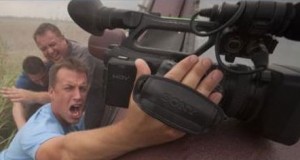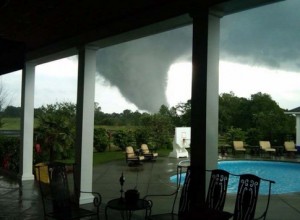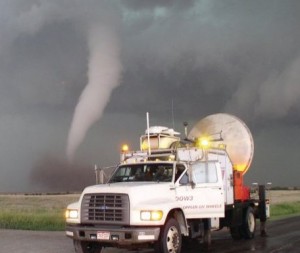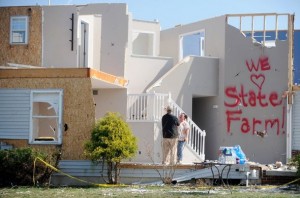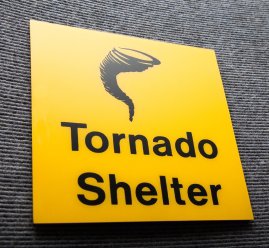 The southern states and east of the Rocky Mountains might be known as “tornado alley,” but a twister can strike nearly anywhere in the U.S. The key to surviving one starts with paying attention, having a plan and don’t stand in its path like Tim Samaras.
The southern states and east of the Rocky Mountains might be known as “tornado alley,” but a twister can strike nearly anywhere in the U.S. The key to surviving one starts with paying attention, having a plan and don’t stand in its path like Tim Samaras.
As director of the scientific field program Tactical Weather Instrumented Sampling in Tornadoes EXperiment, Samaras’s work is featured on the Discovery Channel show “Storm Chasers.” He’s also the only person to obtain readings and pictures from inside a tornado, using probes he invented, and he spends tornado season placing them in the way of oncoming storms.
“The best thing for Joe Public to do is to tune in to local media and also to have a National Weather Service radio to listen to during the spring in case they’re under a tornado watch or a tornado warning,” Samaras says. “Hopefully they already have a plan of action for when the time of need comes.”
Part of knowing what to do starts with knowing what not to do, as there’s a lot of myths when it comes to tornadoes, according to Dr. Kenneth Blumenfeld director of projects at ORC International, a global research firm, and a visiting professor at the University of Minnesota. Even large cities are not immune to their wrath.
“A real common myth is that tornadoes don’t come here, wherever ‘here’ is. It’s very common, people will see some suburb or some area that seems to get hit more and they assume that tornadoes don’t come here,” Blumenfeld says. “It’s always going to seem like they’re somewhere else but there have been a lot of tragedies that you can attribute to people just assuming that they were safe from tornadoes.”
Blumenfeld says tornados often start on a calm day with the sky suddenly turning into a dark and ominous thunderstorm. They typically arrive in the afternoon but can happen at any time, day or night.
Clouds might turn green, yellow or orange and look like they’re starting to converge, indicating the formation of a tornado. Hail can sometimes signal a tornado’s approach, but it does not happen with every storm.
Wall clouds, a dropping of the cloud base into a dark mass from where a funnel cloud might descend, are common but don’t happen with every tornado and might not even be visible. Rain can often be so thick and whipped around by the wind that it obscures the tornado itself.
Although the National Weather Service offers free classes on how to spot a tornado, experts say amateurs should not go out looking for one. They suggest relying on the media, a weather radio or a smartphone app for information and stay ready to act in a moment’s notice.
“Some of these tornadoes are actually rain wrapped so that is what you see if you step outside during a tornado warning, more often than not what you’ll see is a whole bunch of rain and the tornado may be buried in the rain so it’s really not recommended to go out and try to find a tornado,” Samaras says. “If your area is under a tornado warning your best bet is to seek shelter.”
Contrary to another old myth, the southwest corner of a basement isn’t better than any other corner. In fact, the best spot is a basement interior room, away from windows and preferably with some sort of structure to provide support—such as interior walls or a stairwell.
Samaras says under a workbench or a sturdy pool table are good places to hide from falling debris and that a bicycle helmet can offer added protection. A bathtub is another good option, with the family packed in tight and cozy with a small mattress or blankets on top for added protection.
In the old days people would open their windows with the idea of reducing air pressure differences, yet this too is a myth.
“If you’re going to get hit by a tornado, the wind is what’s going to be blowing your walls in and out and not the pressure,” Blumenfeld says. “The time it takes to do it, instead of getting to the basement, could be the difference in surviving and not surviving.”
Those without a basement should find an interior room on the first floor, preferably without windows, and those in trailer homes should find a designated shelter if they can.
Blumenfeld says downtown areas are also vulnerable. Although commercial buildings tend to be more solidly built, their exteriors are often glass windows that turn into shrapnel in strong winds and the buildings themselves create wind tunnels. He suggests seeking shelter in an interior room at the lowest level possible.
If a tornado threatens out on the highway, staying in the car and getting away from it could be the safest option. A typical ground speed for a tornado is around 25 mph or less, although they can travel up to 60 mph or more, especially in the spring when storms are more powerful.
Blumenfeld says tornados can change paths but often move in more or less the same direction, so outrunning one might be possible.
“A lot of times a tornado is merely crossing the road three miles behind you and is not going to actually hit you directly, in which case you probably just want to keep driving away from it,” Blumenfeld says.
Samaras suggests driving at right angles from the tornado to move away from it—unless it’s getting too close, in which case a driver could become confused and drive into its path.
Tornadoes can turn cars into missiles and smash them to bits, so if it’s impossible to get away from a twister the best option is to get out of the car and into a ditch with hands over the head.
“The idea is you get into a low-lying ditch, all of the debris will pass over the top of you and not necessarily down into that culvert,” Samaras says. “Wind is not the issue—it’s the wind that’s picking up all that debris: two by fours, cars, trucks, gravel, farm machinery, you name it.”
Seeking shelter under a highway overpass is the wrong approach, as it can create a wind tunnel effect where the tornado strengthens and sucks people right out of their hiding place.
When Piedmont, Okla. suffered a tornado on May 24, 2011 local insurance agent Denise Johnson saw firsthand the kind of damage such a storm can cause. It destroyed more than 100 homes in this small town near Oklahoma City. It also killed two children and caused more than $20 million in damage.
Johnson, vice president at ECI Insurance, says people found their possessions miles away from their homes, while a horse was blown through the air into a filled swimming pool and survived. Her agency had six total losses among its clients and about a dozen partial losses. A year after the storm, people were still finishing the rebuilding of their homes.
She says people need to prepare for tornado season by making sure their home is insured for its full replacement value, on their homeowner’s insurance policy rather than just its market value, so they can afford to rebuild after a storm. A market value is what a home would sell for today, while replacement value covers the insured for the cost of rebuilding anew.
“My personal house was built in 1899 so I don’t know what the cost of my house would’ve been in 1899 but if it blew down tomorrow and I had to rebuild it, it would obviously cost more than it did then,” Johnson says.
She says many people fail to fully estimate the replacement cost of their personal items because their furniture, clothes and other items were accumulated over time so the total price tag can be hard for them to calculate. Another common mistake is for collectors of any kind to not have documentation of their possessions to prove ownership and value.
Johnson recommends keeping track of all personal items and keep important papers in a safe deposit box, which are usually kept underground, as anything in the home could wind up miles away or might never be found.
“What we found out with a tornado is that a fireproof safe is great if you’re in a fire, but it’s not very good if you’re in a tornado that it all blows away,” Johnson says.
Debris removal was covered by homeowner’s insurance policies. They also provided loss of use funds to help with the cost of buying clothes and finding a place to stay—with the amount depending on the value of the house.
She also recommends having an insurance policy, policy number and contact information for the insurance agent and their company on hand, in case of an emergency. Johnson says phone service, including cell phones, was disrupted after the tornado hit, but text messages could still get through.
Although her business was spared by the tornado it was hit by a major windstorm the following summer, which knocked out power for weeks. Fortunately for the agents, they had a backup generator on hand and could use their laptops and cell phones to keep the business operating.
This article was originally published by Consumer Insurance Guide


